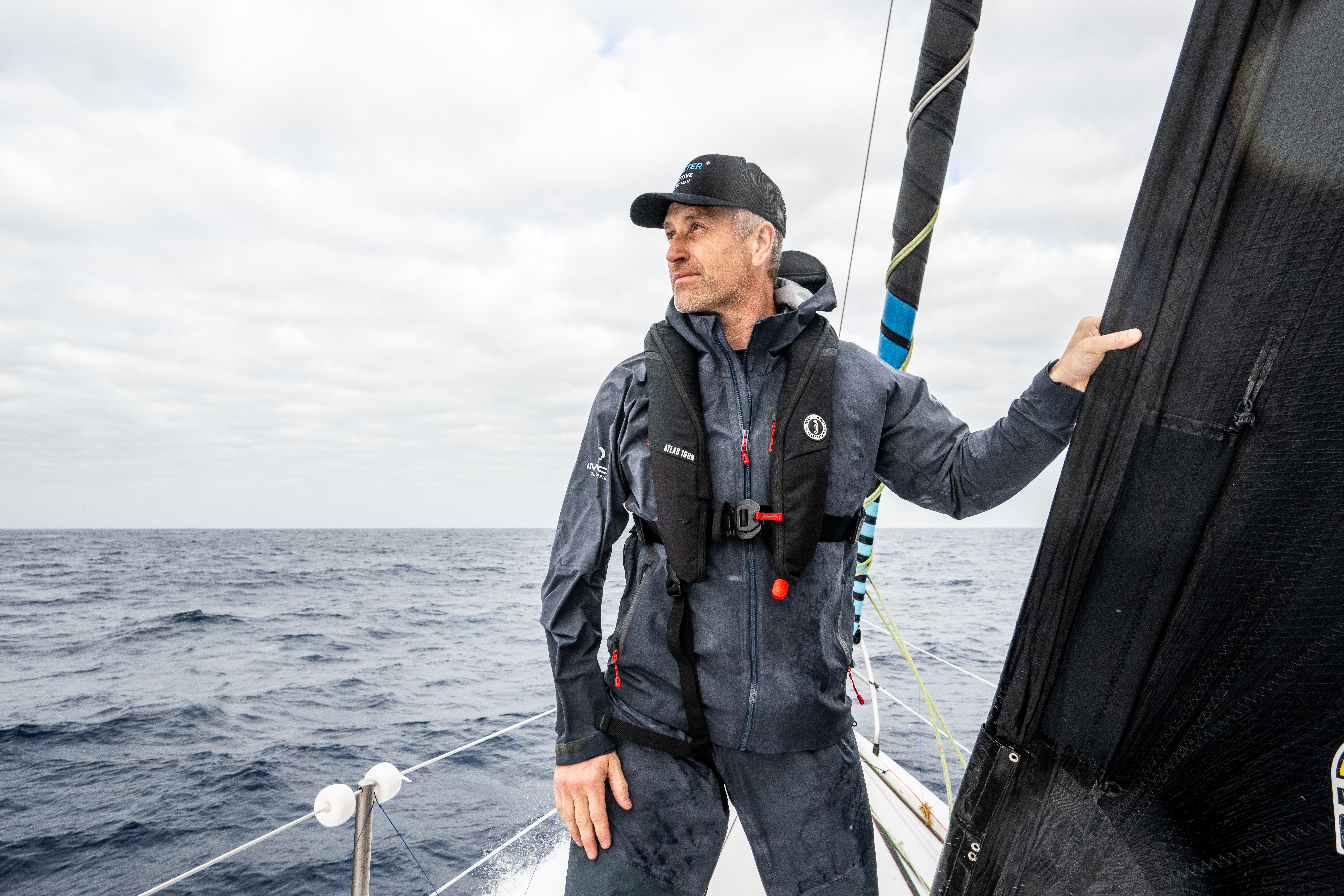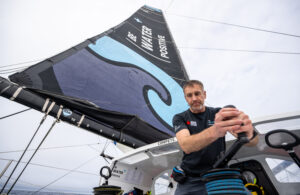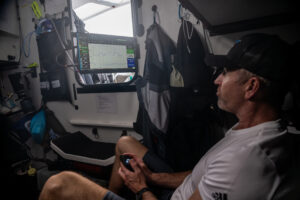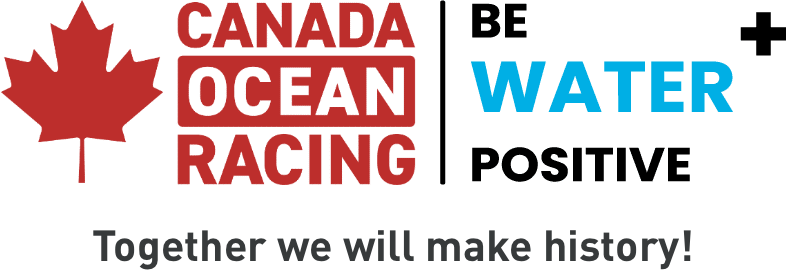
28 Mar March Training Update
March Training Update
Upon arrival in Portugal, we noticed that we were now sharing our pontoon space with offshore fishing fleets seeking refuge in Marina de Cascais from yet more wild weather battering the Southeastern European coastline. There was no question that our decision and plan to push back our departure date was clearly the right call. Although the strong winds are forecast to abate over the next 48 hours, the 5+ meter seas will continue to be a dominant factor for my scheduled March training block.
It is normal for offshore sailors to study the weather, but for many of us who work and play in the natural environment, both recreationally and professionally, we are experiencing abnormality and change that we are working hard to understand. We have already experienced our desired quota of training in heavy weather conditions this year. These conditions were necessary for us to thoroughly test both developments in the boat and in myself. Sailing in storms is much of a management exercise; you focus on protecting all assets: the people, the boat, the equipment, seamanship, and avoiding unnecessary risk. This often leads to spending long hours or even days simply hanging on to anything rigid, either on deck or inside this carbon fiber, horrendously loud and violent race boat.
Now, it is time for milder conditions that would permit us the opportunity to test more modifications in a more controlled manner. The first period of this session was focused on several key elements. It is clear that the process of me traveling to the boat is disruptive, especially when combined with a time zone change, and doesn’t create the best base for finding my sleep and personal management rhythm at sea. Therefore, a focus was to better manage every aspect of my time between leaving home and hoisting my sails.

For this session, we commenced with a list of actions vital to risk management to be worked through while dockside. We walked through the boat, considering every possible failure that could occur and how these breakages or issues could be best managed in the safest and lowest-risk process possible. This also entailed refining my solo mast climbing equipment and technique.
We aim for every hour that I spend on-site to drive the project and my learning forward. This also extends to the wider team. Usually, I arrive and quickly set sail with either my race team partner (if in a double-handed format) or with my coach and our boat captain, while others who are equally valuable to the success of the project remain ashore. Having time with these team members strengthens our bond and our friendship. I am reliant on their willingness and dedication to work diligently towards every goal that we set in order to achieve the right outcome. For this trip, the main focus was for me to sail completely alone for a 24-hour period for the first time on this journey and onboard such a powerful boat. It is these people who have prepared the boat and created this opportunity for me, and for that, I am incredibly grateful.
After two productive days ashore, we left the dock early on Monday, March 11. My shore team joined me for the first part of the session, testing new developments under real application. Within a few hours, the checklist was completed, and they were transferred to a shuttle boat that would return them to shore. To not sound too cliché or overdramatic, I had literally been longing for this moment since I commenced this journey.
I was drawn to the goal of competing in the 2028 Vendee Globe by the emotion and questions I felt when following previous editions, most notably the 2020-21 race. This was a time when 33 very brave sailors boarded their boats to sail solo around the planet while the world was in the midst of lockdown measures in an effort to manage the COVID-19 pandemic. To me, these sailors were the freest people on earth. Not only did this heavily affect me emotionally, but I also started asking myself, ‘Could I do that? Do I have the skills, the personal management, the mental strength, and the courage to do that?’ And now, my willingness to answer these questions has led me to this moment. I wave to my team one last time before they disappear into the marina. I unfurl the headsail, trim on the mainsail, and head towards the horizon.
I have a list of objectives to achieve over the next 24 hours, but for now, I will just enjoy the freedom, the peace, and the confidence I take from the last two years spent training and racing to now be working towards my first solo Transatlantic in a little over two months from now. I am sailing solo on a unique and radically designed 60-foot IMOCA class yacht named after my two daughters, EMIRA. This is my time, I have earned this, and I sure as hell am going to enjoy it.
As much as I would like to continue to share the romantic notion of the wind in my hair, the tranquillity, and personal excitement and pride, the reality is that within a few short hours, I am required to cross one of the busiest shipping Traffic Separation Schemes (TSS) in Portugal. In fading winds and reduced boat speed, I spend the afternoon managing and adjusting my course and collision alarms and gaining confidence in the protection that I seek in these data-driven tools. This process and working through my job list carry me into darkness and the evening.
Throughout the night hours, I focus on personal preservation: safety, sleep, fuel/food, and hydration. Without a doubt, sleep is proving to be the most challenging. I have several alarms set up for collision avoidance, boat performance parameters, wind changes, power/electricity levels, to name just a few. Add my standard sleep alarm to the list, and I feel at times as though I am trying to sleep in the middle of a busy road with the horns of oncoming traffic.
Like everything in my small world afloat, there is an endless process of development and refinement, and that made up most of my evening. I learned I made some mistakes, I called upon those ashore to share the experience and to seek solutions to small problems or to expand ideas.
While I am at sea in any mode, either training or racing, we have a process ashore where someone in the technical team manages a communication channel consistently in case I have a problem. This is managed in a watch system-style format and shared through the 24-hour cycle amongst the technical team, much in the same way as we sleep in time blocks at sea. It is though strange that when I send a basic update into the group text at 03:49 in the morning, in a split second the thumbs-up acknowledgements appear. Little did I also know that my coach and boat captain were competing to be the first to respond. Knowing that I have such support breaks down the feeling of detachment and solitude, something that is going to be incredibly important. While this step in the project is to spend 24 hours at sea alone, the ultimate goal is to spend 3 months at sea, solo, non-stop, and unassisted, reaching the most remote and extreme corners of our oceans as I race around the world.
In the early hours of the next day and under a bright and beautiful sunrise, my routing indicates that it is time to head back to the dock. A big part of me just wants to keep going, that is a good thing.
The next major milestone for myself and the project is my 1,200-mile solo qualifier for the New York (USA) to Vendee (France) race, I am currently looking at attempting this in the first week of April so stay tuned.
Thanks for being on the journey.


